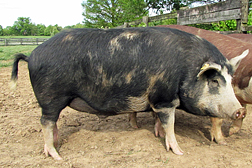This page has been archived and is being provided for reference purposes only. The page is no longer being updated, and therefore, links on the page may be invalid.
| Read the magazine story to find out more. |
|
|
|
|
Pig Breed Serves as Ideal Model for Human Obesity Research
By Rosalie Marion Bliss
May 22, 2014
U.S. Department of Agriculture (USDA) researchers have conducted a series of studies showing that the pig is instrumental as a model for human obesity-related research. Agricultural Research Service (ARS) microbiologist Gloria Solano-Aguilar has found that using swine as a biomedical research model was useful for studying metabolic effects induced by a high-fat diet.
Solano-Aguilar worked with Kati Hanhineva of the University of Eastern Finland in Kuopio to study metabolic changes that occur in pig tissues and biofluids after the pigs consumed a high-fat diet. Solano-Aguilar works at the ARS Beltsville Human Nutrition Research Center (BHNRC) in Beltsville, Maryland. ARS is USDA's chief intramural scientific research agency.
The researchers studied the Ossabaw pig because it has a greater tendency than other pig breeds to deposit excess fat and develop obesity-related diseases when fed a high-calorie diet. The emphasis was on using juvenile pigs as a model for obesity in children. In general, it is difficult to evaluate obesity-related metabolic disturbances in children, according to the scientists.
The researchers wanted to study diet-induced metabolic changes taking place in the tissues they collected from the pigs—liver, pancreas, brain and intestine. They also wanted to compare whether the changes they found in the tissues were present in the pig's urine and plasma, which are biofluids typically collected during human clinical studies.
Pigs in the study were fed either a maintenance diet or a high-fat diet. The researchers found changes in lipid metabolites in all of the analyzed host tissue samples from the pigs fed the high-fat diet. Some tissue-dependent changes were not reflected in the biofluids. Being able to look at organ tissue helped them target changes that are indicative of both disease and poor response to diet.
This study was published in the Journal of Proteome Research in 2013.
Read more about this research in the May/June 2014 issue of Agricultural Research magazine.

